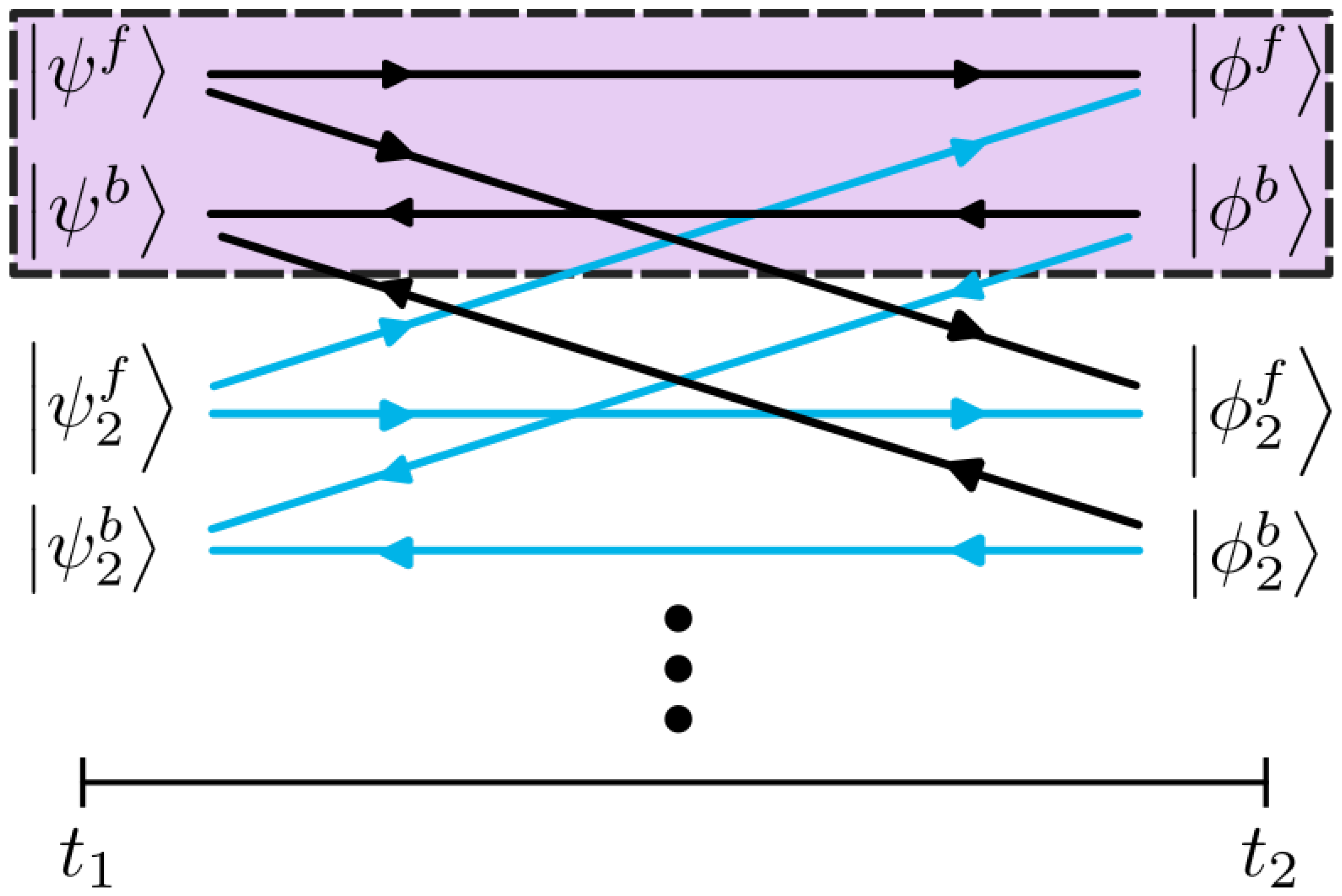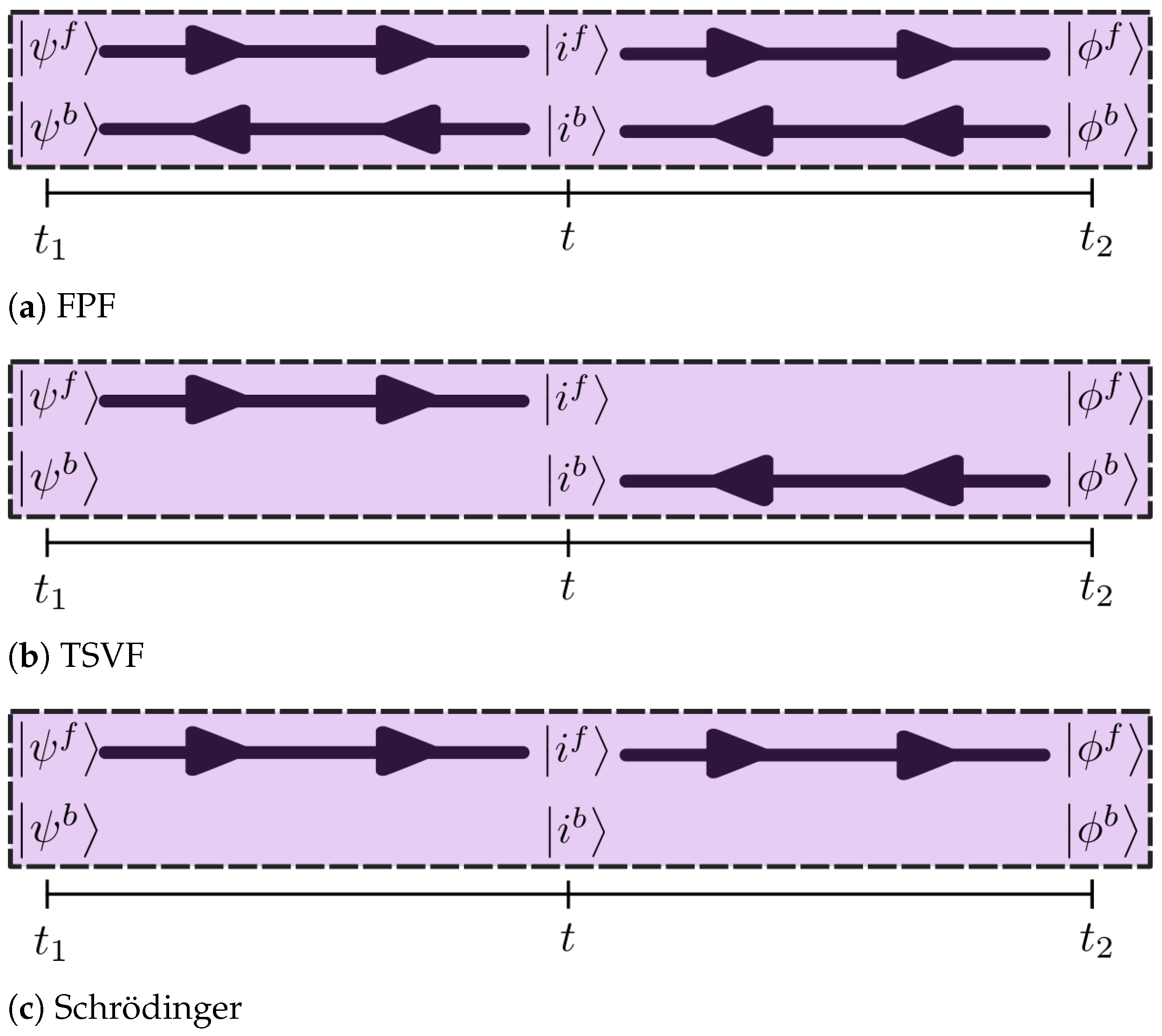Quantum Probability from Temporal Structure
Abstract
1. Introduction
- (a)
- An ontological postulate—The state of a physical system is represented by a wavefunction ;
- (b)
- A dynamical postulate—The state evolves deterministically according to the time-dependent Schrödinger equation (TDSE);
- (c)
- A composition postulate—The state space of a composite system is the tensor product of the spaces of its subsystems;
- (d)
- A statistical postulate—The probability of each measurement outcome is given by the Born measure.
2. The Universal Wavefunction
2.1. General Considerations
- Completeness:The wavefunction is all that exists—it contains all physical properties of nature at all moments in time;
- Measurement Physicality: Measurements are physical processes occurring within temporal regions of the universal wavefunction;
- Event Symmetry: The local description of nature is independent of event location. There are no ontologically privileged spacetime points;
- Self-Location: Temporal boundary constraints provide the only information an observer can use to locate themselves within the wavefunction.
2.2. The Universal Wavefunction on the Keldysh Contour
3. One Fixed Point
4. The Born Measure
5. Three Fixed Points
6. Conclusions
- It is logically parsimonious. The statistical postulate supplies the meaning of probability. However, the mathematical form of probability is not postulated, but derived from ontic and dynamical structure.
- It describes deterministic unitary quantum mechanics with a multiple-event structure which may have implications for quantum gravity [14].
- It makes no theoretical distinction between past, present and future times. A fixed point is simply a crossing point for quantum histories.
- It contains no genuine randomness, only integrals over temporal regions of the wavefunction.
Funding
Institutional Review Board Statement
Informed Consent Statement
Data Availability Statement
Acknowledgments
Conflicts of Interest
References
- Feynman, R.P. The concept of probability in quantum mechanics. In Proceedings of the Second Berkeley Symposium on Mathematical Statistics and Probability; University of California Press: Berkeley, CA, USA, 1951; Volume 533. [Google Scholar]
- Pusey, M.F.; Barrett, J.; Rudolph, T. On the reality of the quantum state. Nat. Phys. 2012, 8, 475–478. [Google Scholar] [CrossRef]
- Colbeck, R.; Renner, R. Is a system’s wave function in one-to-one correspondence with its elements of reality? Phys. Rev. Lett. 2012, 108, 150402. [Google Scholar] [CrossRef] [PubMed]
- Ringbauer, M.; Duffus, B.; Branciard, C.; Cavalcanti, E.G.; White, A.G.; Fedrizzi, A. Measurements on the reality of the wavefunction. Nat. Phys. 2015, 11, 249–254. [Google Scholar] [CrossRef]
- Deutsch, D. Quantum theory of probability and decisions. Proc. R. Soc. Lond. A 1999, 455, 3129–3137. [Google Scholar] [CrossRef]
- Zurek, W.H. Environment-assisted invariance, entanglement, and probabilities in quantum physics. Phys. Rev. Lett. 2003, 90, 120404. [Google Scholar] [CrossRef]
- Zurek, W.H. Probabilities from entanglement, Born’s rule pk=∣ψk∣2 from envariance. Phys. Rev. A 2005, 71, 052105. [Google Scholar] [CrossRef]
- Wallace, D. The Emergent Multiverse: Quantum Theory according to the Everett Interpretation; Oxford University Press: Oxford, UK, 2012. [Google Scholar]
- Sebens, C.T.; Carroll, S.M. Self-locating Uncertainty and the Origin of Probability in Everettian Quantum Mechanics. Br. J. Philos. Sci. 2018, 69, 25–74. [Google Scholar] [CrossRef]
- Vaidman, L. All is Ψ. J. Phys. Conf. Ser. 2016, 701, 012020. [Google Scholar] [CrossRef]
- Vaidman, L. Derivations of the Born rule. In Quantum, Probability, Logic: The Work and Influence of Itamar Pitowsky; Springer Nature: Cham, Switzerland, 2020; pp. 567–584. [Google Scholar]
- Vaidman, L. On schizophrenic experiences of the neutron or why we should believe in the many-worlds interpretation of quantum theory. Int. Stud. Philos. Sci. 1998, 12, 245–261. [Google Scholar] [CrossRef]
- Horwitz, L.; Arshansky, R.; Elitzur, A. On the two aspects of time: The distinction and its implications. Found. Phys. 1988, 18, 1159–1193. [Google Scholar] [CrossRef]
- Maccone, L. A fundamental problem in quantizing general relativity. Found. Phys. 2019, 49, 1394–1403. [Google Scholar] [CrossRef]
- Page, D.N.; Wootters, W.K. Evolution without evolution: Dynamics described by stationary observables. Phys. Rev. D 1983, 27, 2885. [Google Scholar] [CrossRef]
- Marletto, C.; Vedral, V. Evolution without evolution and without ambiguities. Phys. Rev. D 2017, 95, 043510. [Google Scholar] [CrossRef]
- Maccone, L.; Sacha, K. Quantum measurements of time. Phys. Rev. Lett. 2020, 124, 110402. [Google Scholar] [CrossRef] [PubMed]
- Pauli, W. Die Allgemeinen Prinzipien der Wellenmechanik; Springer: Berlin/Heidelberg, Germany, 1933. [Google Scholar]
- Unruh, W.G.; Wald, R.M. Time and the interpretation of canonical quantum gravity. Phys. Rev. D 1989, 40, 2598. [Google Scholar] [CrossRef]
- Aharonov, Y.; Bergmann, P.G.; Lebowitz, J.L. Time symmetry in the quantum process of measurement. Phys. Rev. 1964, 134, B1410. [Google Scholar] [CrossRef]
- Aharonov, Y.; Vaidman, L. The two-state vector formalism: An updated review. Time Quantum Mech. 2008, 734, 399–447. [Google Scholar]
- Aharonov, Y.; Cohen, E.; Gruss, E.; Landsberger, T. Measurement and collapse within the two-state vector formalism. Quant. Stud. Math. Found. 2014, 1, 133–146. [Google Scholar] [CrossRef]
- Aharonov, Y.; Albert, D.Z. Is the usual notion of time evolution adequate for quantum-mechanical systems? I. Phys. Rev. D 1984, 29, 223. [Google Scholar] [CrossRef]
- Aharonov, Y.; Popescu, S.; Tollaksen, J.; Vaidman, L. Multiple-time states and multiple-time measurements in quantum mechanics. Phys. Rev. A 2009, 79, 052110. [Google Scholar] [CrossRef]
- Heller, M. Temporal parts of four dimensional objects. Philos. Stud. 1984, 46, 323–334. [Google Scholar] [CrossRef]
- Aharonov, Y.; Popescu, S.; Tollaksen, J. Each instant of time a new universe. In Quantum Theory: A Two-Time Success Story: Yakir Aharonov Festschrift; Springer: Milan, Italy, 2014; pp. 21–36. [Google Scholar]
- Lundeen, J.S.; Steinberg, A.M. Experimental joint weak measurement on a photon pair as a probe of Hardy’s paradox. Phys. Rev. Lett. 2009, 102, 020404. [Google Scholar] [CrossRef]
- Vaidman, L. Past of a quantum particle. Phys. Rev. A 2013, 87, 052104. [Google Scholar] [CrossRef]
- Curic, D.; Richardson, M.C.; Thekkadath, G.S.; Flórez, J.; Giner, L.; Lundeen, J.S. Experimental investigation of measurement-induced disturbance and time symmetry in quantum physics. Phys. Rev. A 2018, 97, 042128. [Google Scholar] [CrossRef]
- Watanabe, S. Symmetry of physical laws. Part III. Prediction and retrodiction. Rev. Mod. Phys. 1955, 27, 179. [Google Scholar] [CrossRef]
- de Beauregard, C.O. Time symmetry and interpretation of quantum mechanics. Found. Phys. 1976, 6, 539–559. [Google Scholar] [CrossRef]
- Cramer, J. The transactional interpretation of quantum mechanics. Rev. Mod. Phys. 1986, 58, 647. [Google Scholar] [CrossRef]
- Wharton, K.B. Time-symmetric quantum mechanics. Found. Phys. 2007, 37, 159–168. [Google Scholar] [CrossRef]
- Price, H. Toy models for retrocausality. Stud. Hist. Philos. Sci. Part B Stud. Hist. Philos. Mod. Phys. 2008, 39, 752–761. [Google Scholar] [CrossRef]
- Argaman, N. Bell’s theorem and the causal arrow of time. Am. J. Phys. 2010, 78, 1007–1013. [Google Scholar] [CrossRef]
- Leifer, M.S.; Pusey, M.F. Is a time symmetric interpretation of quantum theory possible without retrocausality? Proc. R. Soc. A Math. Phys. Eng. Sci. 2017, 473, 20160607. [Google Scholar] [CrossRef] [PubMed]
- Zych, M.; Costa, F.; Pikovski, I.; Brukner, Č. Bell’s theorem for temporal order. Nat. Comm. 2019, 10, 3772. [Google Scholar] [CrossRef] [PubMed]
- Castro-Ruiz, E.; Giacomini, F.; Belenchia, A.; Brukner, Č. Quantum clocks and the temporal localisability of events in the presence of gravitating quantum systems. Nat. Comm. 2020, 11, 2672. [Google Scholar] [CrossRef]
- Drummond, P.D.; Reid, M.D. Retrocausal model of reality for quantum fields. Phys. Rev. Res. 2020, 2, 033266. [Google Scholar] [CrossRef]
- Keldysh, L.V. Diagram technique for nonequilibrium processes. Zh. Eksp. Teor. Fiz 1964, 47, 151–165. [Google Scholar]
- Stefanucci, G.; van Leeuwen, R. Nonequilibrium Many-Body Theory of Quantum Systems: A Modern Introduction; Cambridge University Press: Cambridge, UK, 2013. [Google Scholar]
- Ridley, M.; Tuovinen, R. Formal equivalence between partitioned and partition-free quenches in quantum transport. J. Low Temp. Phys. 2018, 191, 380–392. [Google Scholar] [CrossRef]
- Tang, G.M. Full-counting statistics of charge and spin transport in the transient regime: A nonequilibrium Green’s function approach. Phys. Rev. B 2014, 90, 195422. [Google Scholar] [CrossRef]
- Esposito, M.; Ochoa, M.A.; Galperin, M. Quantum thermodynamics: A nonequilibrium Green’s function approach. Phys. Rev. Lett. 2015, 114, 080602. [Google Scholar] [CrossRef] [PubMed]
- Aeberhard, U.; Rau, U. Microscopic perspective on photovoltaic reciprocity in ultrathin solar cells. Phys. Rev. Lett. 2017, 118, 247702. [Google Scholar] [CrossRef]
- Hořava, P.; Mogni, C.J. String perturbation theory on the Schwinger-Keldysh time contour. Phys. Rev. Lett. 2020, 125, 261602. [Google Scholar] [CrossRef]
- Tuovinen, R.; Golež, D.; Eckstein, M.; Sentef, M.A. Comparing the generalized Kadanoff-Baym ansatz with the full Kadanoff-Baym equations for an excitonic insulator out of equilibrium. Phys. Rev. B 2020, 102, 115157. [Google Scholar] [CrossRef]
- Atanasova, H.; Lichtenstein, A.I.; Cohen, G. Correlated nonequilibrium steady states without energy flux. Phys. Rev. B 2020, 101, 174316. [Google Scholar] [CrossRef]
- Ridley, M.; Talarico, N.W.; Karlsson, D.; Gullo, N.L.; Tuovinen, R. A many-body approach to transport in quantum systems: From the transient regime to the stationary state. J. Phys. A Math. Theor. 2022, 55, 273001. [Google Scholar] [CrossRef]
- Griffiths, R.B. What quantum measurements measure. Phys. Rev. A 2017, 96, 032110. [Google Scholar] [CrossRef]
- Hartle, J.; Hertog, T. One bubble to rule them all. Phys. Rev. D 2017, 95, 123502. [Google Scholar] [CrossRef]
- Isham, C.J.; Linden, N. Continuous histories and the history group in generalized quantum theory. J. Math. Phys. 1995, 36, 5392–5408. [Google Scholar] [CrossRef]
- Isham, C.J.; Linden, N.; Savvidou, K.; Schreckenberg, S. Continuous time and consistent histories. J. Math. Phys. 1998, 39, 1818–1834. [Google Scholar] [CrossRef]
- Oreshkov, O.; Cerf, N.J. Operational formulation of time reversal in quantum theory. Nat. Phys. 2015, 11, 853–858. [Google Scholar] [CrossRef]
- Gell-Mann, M.; Hartle, J.B. Quantum mechanics in the light of quantum cosmology. In Foundations of Quantum Mechanics in the Light of New Technology: Selected Papers from the Proceedings of the First through Fourth International Symposia on Foundations of Quantum Mechanics; World Scientific Publishing: Singapore, 1996; pp. 347–369. [Google Scholar]
- Dürr, D.; Goldstein, S.; Tumulka, R.; Zanghï, N. Bohmian mechanics and quantum field theory. Phys. Rev. Lett. 2004, 93, 090402. [Google Scholar] [CrossRef] [PubMed]
- Ghirardi, G.C.; Rimini, A.; Weber, T. Unified dynamics for microscopic and macroscopic systems. Phys. Rev. B 1986, 34, 470. [Google Scholar] [CrossRef] [PubMed]
- Vinante, A.; Mezzena, R.; Falferi, P.; Carlesso, M.; Bassi, A. Improved noninterferometric test of collapse models using ultracold cantilevers. Phys. Rev. Lett. 2017, 119, 110401. [Google Scholar] [CrossRef] [PubMed]
- Bohm, D. A suggested interpretation of the quantum theory in terms of “hidden” variables. I. Phys. Rev. 1952, 85, 166. [Google Scholar] [CrossRef]
- Everett, H. “Relative state” formulation of quantum mechanics. Rev. Mod. Phys. 1957, 29, 454. [Google Scholar] [CrossRef]





Disclaimer/Publisher’s Note: The statements, opinions and data contained in all publications are solely those of the individual author(s) and contributor(s) and not of MDPI and/or the editor(s). MDPI and/or the editor(s) disclaim responsibility for any injury to people or property resulting from any ideas, methods, instructions or products referred to in the content. |
© 2023 by the author. Licensee MDPI, Basel, Switzerland. This article is an open access article distributed under the terms and conditions of the Creative Commons Attribution (CC BY) license (https://creativecommons.org/licenses/by/4.0/).
Share and Cite
Ridley, M. Quantum Probability from Temporal Structure. Quantum Rep. 2023, 5, 496-509. https://doi.org/10.3390/quantum5020033
Ridley M. Quantum Probability from Temporal Structure. Quantum Reports. 2023; 5(2):496-509. https://doi.org/10.3390/quantum5020033
Chicago/Turabian StyleRidley, Michael. 2023. "Quantum Probability from Temporal Structure" Quantum Reports 5, no. 2: 496-509. https://doi.org/10.3390/quantum5020033
APA StyleRidley, M. (2023). Quantum Probability from Temporal Structure. Quantum Reports, 5(2), 496-509. https://doi.org/10.3390/quantum5020033




